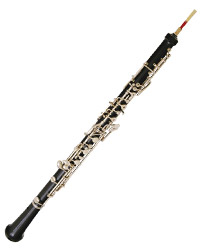instrument: Oboe
 Technically, the term "oboe" is a generic for any double-reed instrument (as opposed to the single reed clarinet or saxophone) – including the bassoon and English horn. In practice, however, the term is used to indicate the principal (treble) oboe, pitched in C. Many cultures have double reed instruments, dating back at least to the Ancient Greek aulos; in Europe, the oboe descended most directly from the shawm – a double reed wind instrument made in various sizes, dating back early Medieval era, that possessed a rather loud and shrill tone, with limited pitch options. Changes in construction made in France during the mid-Baroque allowed the new “hautbois” to better blend with strings, and enter into the art music repertoire – namely, in the operas and ballets of Jean-Baptiste Lully in the 1660s and 70s. The oboe (though, in fact, traditionally called “hautbois” through the end of the 18th century) gained currency in French consorts and orchestras, from where it spread to England, Italy, Germany, and elsewhere. For some time the oboe displayed its roots in the shawm, being performed in consort, and maintaining either a pastoral or a ceremonial association; gradually, though, it revealed its potential as a beautiful and flexible solo instrument – within chamber and orchestral music, as well as opera. The late-Baroque witnessed perhaps the golden age of the oboe, as seen in the many oboe concertos and sonatas by Antonio Vivaldi, George Frideric Handel, Georg Philip Telemann, and Tomaso Albinoni, as well as in the many glorious oboe obbligati that J.S. Bach wrote in his cantatas and other sacred works – such as the famous sinfonia to Cantata No.156. During the Classical era, construction changes gradually gave the oboe a more mellow tone (via a more narrow bore, etc.), particularly in the upper registers, and composers began writing simpler, more harmonically-oriented oboe parts within orchestral and chamber settings; at the same time, the oboe began to cede some of its ensemble importance to the clarinet. Among oboe-featured works in this period include, especially Wolfgang Amadeus Mozart’s Oboe Concerto in C, K.314 and his Oboe Quartet in F, K.370.
Technically, the term "oboe" is a generic for any double-reed instrument (as opposed to the single reed clarinet or saxophone) – including the bassoon and English horn. In practice, however, the term is used to indicate the principal (treble) oboe, pitched in C. Many cultures have double reed instruments, dating back at least to the Ancient Greek aulos; in Europe, the oboe descended most directly from the shawm – a double reed wind instrument made in various sizes, dating back early Medieval era, that possessed a rather loud and shrill tone, with limited pitch options. Changes in construction made in France during the mid-Baroque allowed the new “hautbois” to better blend with strings, and enter into the art music repertoire – namely, in the operas and ballets of Jean-Baptiste Lully in the 1660s and 70s. The oboe (though, in fact, traditionally called “hautbois” through the end of the 18th century) gained currency in French consorts and orchestras, from where it spread to England, Italy, Germany, and elsewhere. For some time the oboe displayed its roots in the shawm, being performed in consort, and maintaining either a pastoral or a ceremonial association; gradually, though, it revealed its potential as a beautiful and flexible solo instrument – within chamber and orchestral music, as well as opera. The late-Baroque witnessed perhaps the golden age of the oboe, as seen in the many oboe concertos and sonatas by Antonio Vivaldi, George Frideric Handel, Georg Philip Telemann, and Tomaso Albinoni, as well as in the many glorious oboe obbligati that J.S. Bach wrote in his cantatas and other sacred works – such as the famous sinfonia to Cantata No.156. During the Classical era, construction changes gradually gave the oboe a more mellow tone (via a more narrow bore, etc.), particularly in the upper registers, and composers began writing simpler, more harmonically-oriented oboe parts within orchestral and chamber settings; at the same time, the oboe began to cede some of its ensemble importance to the clarinet. Among oboe-featured works in this period include, especially Wolfgang Amadeus Mozart’s Oboe Concerto in C, K.314 and his Oboe Quartet in F, K.370.
The 19th century witnessed further changes in oboe construction, most notably via the establishment of various key systems, which allowed for ease of chromatic playing, but likewise resulted in a generally less dynamic tone; these culminated toward the end of the century in the French-built “Conservatoire system” oboe, that remains the dominant instrument used today. Increasingly, the oboe became associated with sweet, lyrical (cantabile) melodies, particularly in slow passages – as heard in various orchestral works by Ludwig van Beethoven, Hector Berlioz, Johannes Brahms, and Richard Wagner. At the same time, a small but steady repertoire of solo works featuring the oboe was written through the Romantic and Late-Romantic eras, including oboe concertos by Vincenzo Bellini and Richard Strauss, and oboe-featured chamber works by Robert Schumann and Camille Saint-Saëns, among others. The Modern and Contemporary eras, indeed, have increased the solo profile of the oboe, with oboe concertos and other oboe-featured works by composers including Ralph Vaughn-Williams, Bohuslav Martinů, Krzysztof Pendercki, Elliott Carter, Hans Henze, and others – in part inspired by such performers as the Swiss virtuoso Heinz Holliger.

Nolan Gasser, PhD
Artistic Director













